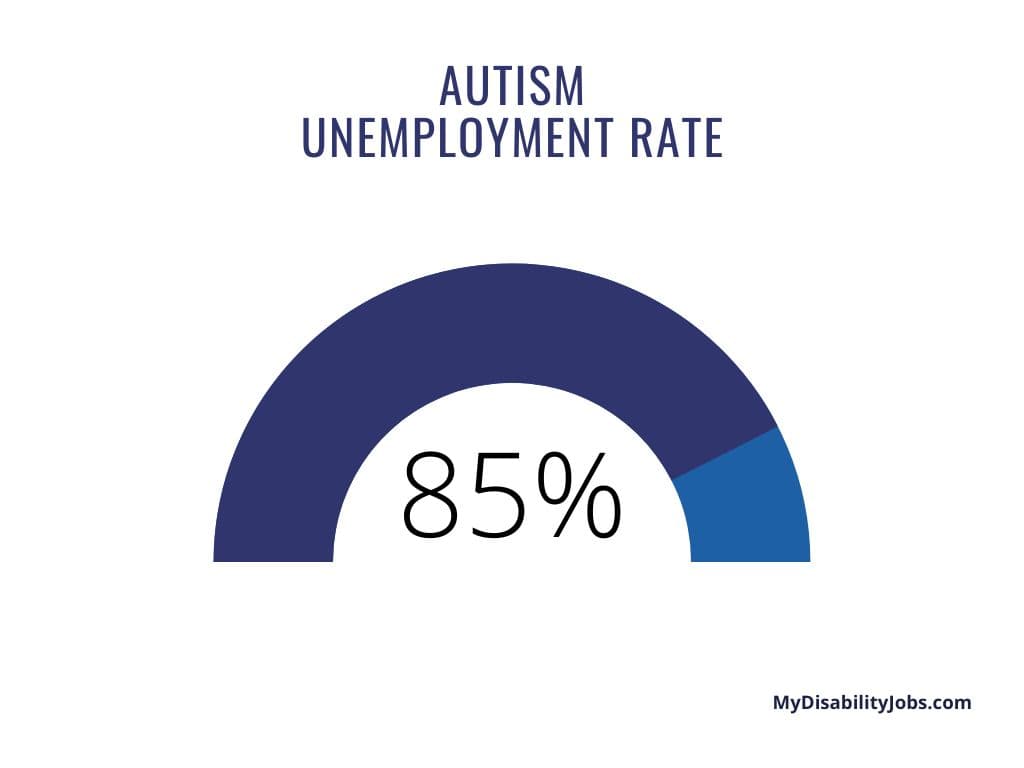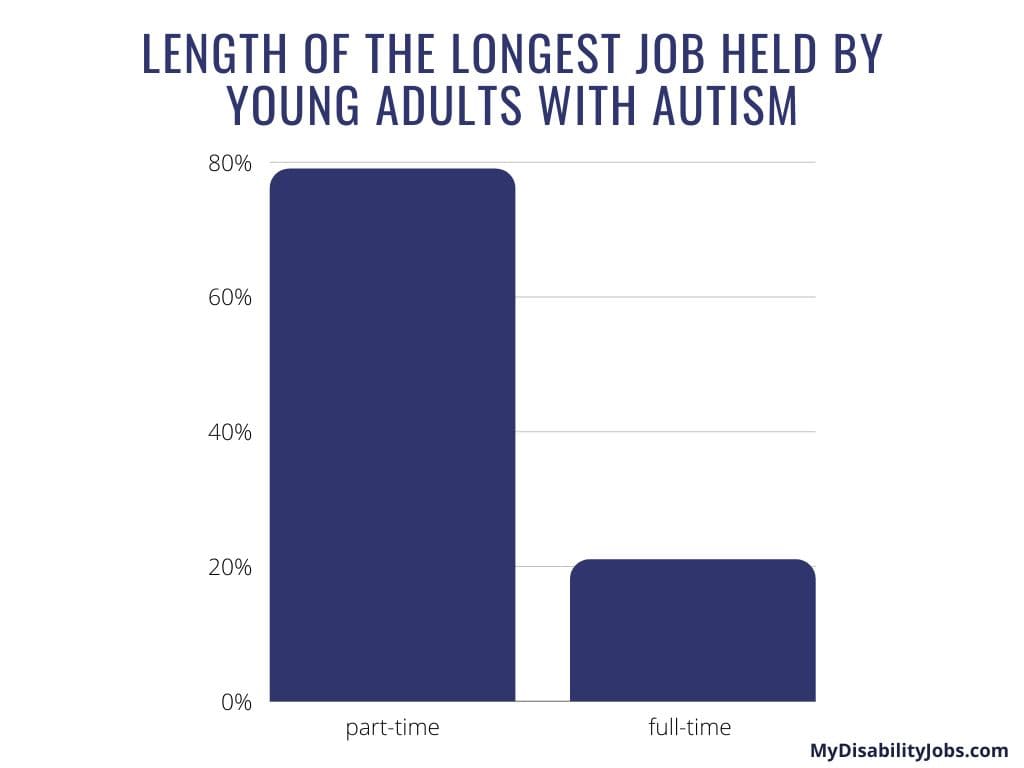Autism and Employment Statistics – Update 2024
People being diagnosed with Autism Spectrum Disorder has been a common occurrence since the 1990s.
What also has been a common occurrence in more recent times is the ongoing lack of employment opportunities for adults with Autism.
In the United States, autistic employees have faced an uphill battle when it comes to securing steady employment. However, there have been some success stories in the autistic community along the way.
Note that, if you’re interested to learn more about neurodiversity at work, we also covered Statistics on Neurodiversity in the Workplace.
Is your company offering jobs for people with disabilities? As an employer, you can publish your job offers on MyDisabilityJobs and reach thousands of qualified candidates.
In this statistic roundup, you’ll learn:
– Autistic Workers and Productivity
Adults with Autism: Employment Statistics (Editor’s Picks)
- US Unemployment Rate: at least 85% of adults that are autistic are unemployed and have a college education.

- Unemployment Rate NY, NJ, MI: In 2017, researchers based in New York, New Jersey, and Minnesota discovered that 38.58% of 254 adults with Autism Spectrum Disorder were unemployed, but the other 61.42% were employed.
- Revealing ASD: Participants who revealed their ASD diagnosis to employers were more than 3 times as likely to become employed than those who withheld their diagnosis.
- Disability Age: In 2021, 50% of people who had a disability were 65 years of age or older.
- Employment-population ratio: 31.4% of those with a disability between the ages of 16 and 64 make up the employment-population ratio, with the participation rate being 35.1%. The unemployment rate of that age demographic with disabilities was 10.8% in 2021. In comparison, this unemployment rate more than doubles the unemployment rate (5.2%) of those without disabilities in the same age demographic.
- Employment Rate: at least 20% of adults that are autistic are employed. Researchers also discovered that a combined 24% of study participants had either part-time or full-time jobs with no outside support.
- Outside Support: a study showed that 7% of participants had supported employment, which means they worked a regular job with outside support from a job coach.
- Sheltered Workshop: a study showed that 14% participated in a sheltered workshop, which is a highly structured work environment where those with significant functional disabilities work in exchange for payment.
- Student Jobs: 4 in every 10 young autistic adults never worked for pay between high school and their early 20s.
Sources: Pubmed, U.S. Department of Labor, National Center for Biotechnology Information, Drexel University
Vocational Rehabilitation
- In 2016, professors at Drexel University conducted a study on how vocational rehabilitation (VR) services impacted adults with ASD. This report finds that 60% of autistic people are employed when they exit VR programs, but has noted that overall employment rates, wages, hours worked, and variation in types of jobs remain low.
- 80% of those who became employed after exiting VR were employed part-time with a median weekly earnings of $160.
- Around 1/3 of those who became employed were in supported employment when they chose to exit VR. This means they received on-the-job support to get employment and stay employed for at least 90 days before stopping VR services.
- In comparison with other disability groups, autistic participants who received VR services made up 3% of all VR service users, whereas those with ID (Intellectual Disability) made up 9%.
- Average expenditures on total services per person were around 20% higher with autistic participants than participants with ID.
- In their National Autism Indicators Report, Drexel found that 58% of young autistic adults worked for pay outside of home between their time in high school and their early 20s.
- The percentage of young autistic adults who had ever been employed gradually increased the longer time passed after high school. The percentage rose from 32% just 0-2 years after high school to 93% after 6-8 years since high school.
Sources: Drexel University, Drexel University
Most Frequent Job Types
One of the main issues regarding employment for those on the Autism Spectrum is the type of job they will end up with. In general, people with autism tend to pay great attention to detail, stick to rigid routines, and prefer to work independently.
- Most young autistic adults have worked in office and administrative support jobs. (19% NLTS2, 26% CSR)
- Alternatively, many other autistic adults have worked in another area other than the listed job types. (24% NLTS2, 18% CSR)
- The second-most filled job type by autistic adults was food preparation and serving. (14% NLTS2, 16% CSR)
- Both the NLTS2 and the CSR counted the same percentage of autistic adults that worked in sales. (13%)
Sources: U.S. Department of Education
Job Length and Wages
It is sometimes hard to measure how long an autistic employee will hang on to his or her job after high school. According to the NLTS2, young autistic adults held an average of around 3 different jobs during their early 20s. 26 months was the average length of the longest job held.

- Concerning job length, 79% of young autistic adults worked part-time jobs, while 21% worked full-time jobs.
- Concerning wages, part-time autistic employees made an average of $9.11 per hour under a 35-hour work week. Full-time autistic employees made an average of $8.08 per hour in a work week of 35 hours or more.
Sources: National Longitudinal Transition Study-2
Encouraged or Discouraged?
Considering the adults with autism employment statistics above, should people on the Autism Spectrum feel encouraged or discouraged by their chances of receiving employment opportunities? By definition, a “Discouraged Worker” is someone who wants to work or is available to work, but has left the labor force because of the assumption there aren’t any jobs available.
- As of April 2023, according to the Bureau of Labor Statistics, an estimated 477,000 are considered to be Discouraged Workers.
- The estimated autism prevalence is 1 in 68 school-aged children.
- If the estimated autism prevalence were to also apply to Discouraged Workers, then there would be an estimated 7,010 Discouraged Workers that are autistic.
Sources: Bureau of Labor, Centers for Disease Control and Prevention
Autistic Workers and Productivity
As awareness of autism has grown over the years, more companies have gradually opened their doors to welcome new autistic employees and so, are offering jobs for autistic people. You might be amazed by which companies in particular have made the path more clear for people with autism to obtain work!
- SAP is a software giant that has firmly established itself as a pioneer in incorporating autistic people into the workforce. They started the Autism at Work program in 2013, and in October 2019 reported a 90% retention rate of hires that were on the autism spectrum.
- Also known as Freddie Mac, the Federal Home Loan Mortgage Corporation is a government-owned entity that partnered with the Autistic Self Advocacy Network (ASAN) to create an Autism Internship Program aim to pair their business needs with the capabilities of autistic workers.
- J.P. Morgan Chase and Co. discovered that more than 300 autistic employees are 48% faster and 92% more productive than their neurotypical employees.
- James Mahoney, the head of Autism at Work (at J.P Morgan Chase and Co), says that autistic employees were as much as 140% more productive than their peers.
- Safeway is a large grocery store chain that has 900 stores located in the western United States. Safeway today employs over 10,000 adults with disabilities, thousands of which are autistic.
Sources: SAP, Autistic Self Advocacy Network (ASAN), J.P. Morgan Chase and Co., Vercida, Progressive Grocer
Is your company offering jobs for people with disabilities? As an employer, you can publish your job offers on MyDisabilityJobs and reach thousands of qualified candidates.
Conclusion
One main thing to conclude from this research is that the door is wide open for autistic workers to both establish and advance their careers, though it may depend on what type of career path one wants to take. With more programs being set up for autistic workers, the more opportunities they will have in achieving their goals.
Discrimination against those on the autism spectrum may still exist in some parts of the workforce, but that amount is decreasing with every passing year. Job opportunities that were previously unattainable for the autistic community are becoming more attainable than ever.
FAQ
It is estimated that 85% of American adults with autism that have a college education are unemployed.
Young autistic adults were employed in part-time jobs in 79% of the cases, whereas full-time jobs were held by 21% of them
Data shows that the employment rate of young adults with autism increased over time after high school. The percentage of those who had ever been employed rose from 32% within 0-2 years after high school to 93% after 6-8 years since high school.
Related articles:
Diversity in the Tech Industry: Statistics
Costs of Bullying and Harassment in the Workplace
Worst Jobs for Autistic Adults and Aspergers
Intellectual Disability Employment Statistics
Workplace Bullying Statistics Research & Facts
Statistics of Diversity in the Workplace
Mental Health and Employment Statistics
Disability and Depression Statistics
Disability and Employment Discrimination Statistics


As one of the few who has grinded through full-time employment (necessity not granting me a choice), I have to say the core issue is less my actual sensitivities and limitations, but rather my trauma response to a lifetime of unaddressed, untreated, and often ignored trauma caused by gaslighting, bullying and scapegoating. Very late in the game I came across research and information regarding ACES and trauma, which have done more for my ability to function in a neurotypical work environment than all my other research combined.
The one criminal issue is that for those of us diagnosed late in life, we are at the mercy of our own survival instinct to seek out our answers. It breaks my heart to think of how many of us are suicidal simply because we missed out on the childhood diagnosis window and now believe there is no hope for us. Many of us are quite gifted, and with the right tools to manage and heal the trauma that life hands out to us, we could make an invaluable contribution to society. Let’s quit shooting our wounded — or hoping they’ll die off on their own. The solutions are pretty simple.. We just need the funding & assistance.
Thank you so much for sharing your thought Elizabeth. The journey might be difficult but it’s never impossible. Wishing you the best.
Unfortunately, I wasn’t diagnosed, with Autism Spectrum Disorder [ASD], until AFTER I had completed both College, and Graduate School, and stumbled in the competitive job market. My ASD diagnosis gave me a lot of insight as to WHY I had always been “Different” from my peers. In: School, Work, Social Events, Church, etc. While the reason for my being “Different” was solved, new problems suddenly surfaced.
Vocational Rehabilitation Services [VRS] is supposed to help us disabled folks get back to work. Once I had my ASD diagnosis, my family thought that VRS could help me with the training, and job placement, for work that was a better “Fit” for me. However, VRS informed me that that just wasn’t allowed. Why Not? Because I had already completed both College, and Graduate School. VRS seemed to figure that IF I was capable of finishing my education, THEN I must have all the tools that a needed for a successful career. Right? Well, my work record shows otherwise. Also, too many jobs makes a person a “Questionable” hire. Today, I’m not working, and collecting Social Security Disability Insurance [SSDI].
ASD affects your entire life. I sure do wish that I had been diagnosed as a child. I could have gotten many helpful services that would have had a positive effect on my life’s outcomes.
Hi Gregory,
Thank you so much for sharing. Unfortunately the system (VRS) is not perfect and definitely needs to be improved to avoid situations like yours.
I hope that you will find a suitable job for you, perhaps an online/remote job might be easier to handle for you?
I was among the unemployed statistic in 2010-2011. I was fortunate to have family to support me through education. I missed out on a lot of the “rites of passage” came with early 20s. I wonder if me having ADHD and mild autism combined contributed. It was also aftermath of the great recession.
Hi Ren, thank you for sharing! We are very happy to hear that you were supported by your family!
Keep it up!
I have the same experience as Aspieman. In fact, my diagnosis came at the request of, and paid for by, VRS – then they dropped me like a hot rock.
23 years of job hunting since getting a business degree (that has a student loan capitalizing at 8.25% interest and now is over $125,000) has been low paid temp/labor. Even in my current job that requires industry certification I only make $16.71/hr – the most I have ever made.
But that’s enough to call me employed as another $1000/mo gets added to my student loans.
I have never understood how the job hunting thing works, but I also have had to work so much in low pay jobs that I never have time to do a “proper” job hunt – because I like to have a place to live and food to eat.
I’ve been trying to figure out how to get a Remote job (since I live in the middle of WY and can’t move) – but now with IT/Social Media firing people in droves, my chances at Remote become even more remote.
When will there ever be a program/system that someone who has to be away from a computer/phone working 12 hrs a day, 6 days a week for a barely subsistence wage can use to find reasonable employment?
Hi Bryan,
Thank you for sharing!
Since you can apply for job offers online and then talk with the recruiters through emails, you still can look for a job during your free time (even spending 1h/week sending proposals).
The key is to apply to jobs that you know you are a good fit for and also try to keep training yourself so you get better in what you apply (if possible).
The problem is, I don’t know what a “good fit” is anymore. “1 hr a week” scanning job boards and LinkedIn has done nothing for me in the past 23 years.
I’ve been stuck doing low pay temp/labor for basic subsistence for so long that nothing on the job boards makes sense. The postings may as well be in Sumerian Cuniform.